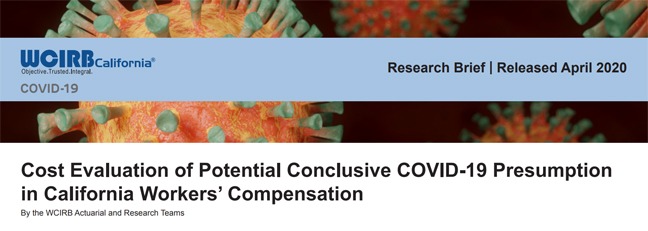Following suit with the research brief from WCIRB. Click here to access.
…done last week by the Workers’ Compensation Insurance Rating Bureau of California (“WCIRB”) on the impact of COVID 19 on the California Workers’ Compensation system, the National Council of Compensation Insurance (“NCCI”) came out yesterday with the same for the 38 States that it tracks for rule and rate-making purposes. Note the numbers below do not include half the country’s volume of workers’ compensation premiums when it is considered States like California (25% on its own), New York and Ohio are not included in the below data.
Key findings of the NCCI on frequency rates:
% of ee’s that will contract COVID 19 on the job – <10% – 81%
-
- it should be noted that the issue of “Presumption of Coverage” related to different types of occupations is the driver of the huge range in frequency – all States are presuming “First Responders” (1,176,110 workers), others to include Healthcare Workers and First Responders (9,666,420 workers) and still others such as Illinois that presumes any worker that is client facing has occupational exposure to the disease (86,351,950 total workers in the 38 States considered)
Infection rate is 5-50% regardless of class of worker above
Range of Impact of COVID losses on overall expected losses by category of worker:
-
- First Responders – Pre-COVID expected losses of $1.1B with potential impact of $.1B – $1.9B… 10%-170% range
- First Responders and Healthcare Workers – Pre-COVID losses of $3B with potential impact of $1B – $16.2B…. 33% – 550% range
- All Workers – PreCovid losses of $32.1B with potential impact of $2.78B – $81.5B… 8 – 254% range
- Hospitalization rate after infection range is 1 – 31%
- Critical care rate of 5 – 27%
- Duration of care for mild symptoms of 2 weeks and 3 – 6 for moderate or critical cases
Cost per claim type:
-
-
- Mild $1,000
- Moderate-Severe $25,500
- Severe $59,000
-
Impact by infection and compensability rates
-
-
- 1% occupationally impacted, cost of loss goes up 8%
- 5% = 42%
- 10% = 85% – which at present is NCCI’s selection
- Fatality rate for those infected with the virus is .5% across all classes of employees – Average impact $146,980 in death benefits (does not include medical)
-
My summation of what the NCCI and WCIRB are projecting is as followed:
- The huge range in expected costs is going to be understood on a State by State basis with the issue of presumption of contraction based on occupational duties being the biggest driver
- As each State has unique payouts for disability and death, the prediction of cost and risk load for pricing needs to be State by State
- The healthcare segment is providing the most unpredictability – add a risk load, park the business elsewhere or stay out of the segment for now – too unpredictable
- PEO’s can be a very important partner to insurance carriers by allowing them to understand performance data fastest due to their management of payroll
- The smartest people I know do not know what to predict but this is a start – we probably will not have enough real data to narrow this range of expectations for months
Stay safe and we will get through this – but with our eyes open.
Join the Conversation on Linkedin | About PEO Compass
The PEO Compass is a friendly convergence of professionals and friends in the PEO industry sharing insights, ideas and intelligence to make us all better.
All writers specialize in Professional Employer Organization (PEO) business services such as Workers Compensation, Mergers & Acquisitions, Data Management, Employment Practices Liability (EPLI), Cyber Liability Insurance, Health Insurance, Occupational Accident Insurance, Business Insurance, Client Company, Casualty Insurance, Disability Insurance and more.
To contact a PEO expert, please visit Libertate Insurance Services, LLC and RiskMD.
